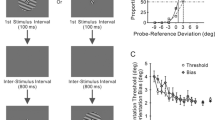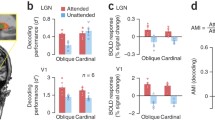Abstract
Using psychophysical methods, the present study aims to investigate whether orientation discrimination learning can modify the visual cortex and how the modification is related to the development of perceptual learning (performance improvement). In Experiment 1, subjects were trained with an orientation discrimination task at the orientation of 15° right tilted from the vertical. The training not only improved subjects’ orientation discrimination performance, but also shifted their perceived vertical toward the trained orientation, which resembles a well-known visual illusion—tilt aftereffect. Interestingly, the change of perceived vertical and performance improvement had different dynamics. Subjects’ performance levels were maintained at a constant level, even 2 months after training. However, their perceived vertical changes reduced dramatically 1 week after training. In addition, Experiment 1 showed that there was only a weak transfer of the perceived vertical change from the trained location to the untrained location. Experiment 2 demonstrated that subjects’ perceived vertical was not affected by training at 75°. These results suggest that the orientation discrimination training could modify neuronal responses in human retinotopic visual areas and the development of perceptual learning is not a single neural process.





Similar content being viewed by others
References
Ball K, Sekuler R (1987) Direction-specific improvement in motion discrimination. Vis Res 27:953–965
Berardi N, Fiorentini A (1987) Interhemispheric transfer of visual information in humans: spatial characteristics. J Physiol 384:633–647
Bi T, Chen N, Weng Q, He D, Fang F (2010) Learning to discriminate face views. J Neurophysiol 104:3305–3311
Carandini M, Movshon JA, Ferster D (1998) Pattern adaptation and cross-orientation interactions in the primary visual cortex. Neuropharmacology 37:501–511
Clifford CWG, Wenderoth P, Spehar B (2000) A functional angle on some after-effects in cortical vision. Proc R Soc Lond B Biol Sci 267:1705–1710
Crist RE, Li W, Gilbert CD (2001) Learning to see: experience and attention in primary visual cortex. Nat Neurosci 4:519–525
Dosher BA, Lu ZL (1998) Perceptual learning reflects external noise filtering and internal noise reduction through channel reweighting. Proc Natl Acad Sci USA 95:13988–13993
Fahle M, Edelman S (1993) Long-term learning in Vernier acuity: effects of stimulus orientation, range and of feedback. Vis Res 33:397–412
Fang F, Murray SO, Kersten D, He S (2005) Orientation-tuned fMRI adaptation in human visual cortex. J Neurophysiol 94:4188–4195
Fang F, Ijichi K, He S (2007) Transfer of the face viewpoint aftereffect from adaptation to difference and inverted faces. J Vis 7(13):6, 1–9
Fendick M, Westheimer G (1983) Effects of practice and the separation of test targets on foveal and peripheral stereoacuity. Vis Res 23:145–150
Furmanski CS, Engel SA (2000) Perceptual learning in object recognition: object specificity and size invariance. Vis Res 40:473–484
Ghose GM, Yang T, Maunsell JHR (2002) Physiological correlates of perceptual learning in monkey V1 and V2. J Neurophysiol 87:1867–1888
Gilbert CD, Sigman M, Crist RE (2001) The neural basis of perceptual learning. Neuron 31:681–697
Gold JI, Watanabe T (2010) Perceptual learning. Curr Biol 20:R46–R48
Jehee J, Ling S, Swisher J, Tong F (2010) Neural correlates of perceptual learning in the human visual cortex. J Vis 10(7):1133
Jeter PE, Dosher BA, Petrov A, Lu Z (2009) Task precision at transfer determines specificity of perceptual learning. J Vis 9(3):11–13
Karni A, Sagi D (1991) Where practice makes perfect in texture discrimination: evidence for primary visual cortex plasticity. Proc Natl Acad Sci USA 88:4966–4970
Law CT, Gold JI (2008) Neural correlates of perceptual learning in a sensory-motor, but not a sensory, cortical area. Nat Neurosci 11:505–513
McAdams CJ, Maunsell JHR (1999) Effects of attention on orientation-tuning functions of single neurons in macaque cortical area V4. J Neurosci 19:431–441
Mollon JD, Danilova MV (1996) Three remarks on perceptual learning. Spat Vis 10:51–58
Movshon JA, Lennie P (1979) Pattern-selective adaptation in visual cortical neurones. Nature 278:850–852
Poggio T, Fahle M, Edelman S (1992) Fase perceptual learning in visual hyperacuity. Science 256:1018–1021
Pouget A, Dayan P, Zemel R (2003) Inference and computation with population codes. Annu Rev Neurosci 26:381–410
Raiguel S, Vogels R, Mysore SG, Orban GA (2006) Learning to see the difference specifically alters the most informative V4 neurons. J Neurosci 26:6589–6602
Schoups AA, Vogels R, Orban GA (1995) Human perceptual learning in identifying the oblique orientation: retinotopy, orientation specificity and monocularity. J Physiol 483:797–810
Schoups A, Vogels R, Qian N, Orban G (2001) Practising orientation identification improves orientation coding in V1 neurons. Nature 412:549–553
Sigman M, Gilbert CD (2000) Learning to find a shape. Nat Neurosci 3:264–269
Vogels R (1990) Population coding of stimulus orientation by striate cortical cells. Biol Cybern 64:25–31
Watson AB, Pelli DG (1983) QUEST: a Bayesian adaptive psychometric method. Percep Psychophy 33:113–120
Xiao L, Zhang J, Wang R, Klein SA, Levi DM, Yu C (2008) Complete transfer of perceptual learning across retinal locations enabled by double training. Curr Biol 18:1922–1926
Yang T, Maunsell JHR (2004) The effect of perceptual learning on neuronal responses in monkey visual area V4. J Neurosci 24:1617–1626
Yotsumoto Y, Watanabe T, Sasaki Y (2008) Different dynamics of performance and brain activation in the time course of perceptual learning. Neuron 57:827–833
Yu C, Klein SA, Levi DM (2004) Perceptual learning in contrast discrimination and the (minimal) role of context. J Vis 4:169–182
Zhang E, Li W (2010) Perceptual learning beyond retinotopic reference frame. Proc Natl Acad Sci USA 107:15969–15974
Zhang J, Zhang G, Xiao L, Klein SA, Levi DM, Yu C (2010) Rule-based learning explains visual perceptual learning and its specificity and transfer. J Neurosci 30:12323–12328
Acknowledgments
We thank Qingleng Tan for her assistance in data collection. This work was supported by the Ministry of Science and Technology of China (2011CBA00405 and 2010CB833903), the National Natural Science Foundation of China (Project 30925014, 90920012 and 30870762) and the Fundamental Research Funds for the Central Universities.
Author information
Authors and Affiliations
Corresponding author
Rights and permissions
About this article
Cite this article
Chen, N., Fang, F. Tilt aftereffect from orientation discrimination learning. Exp Brain Res 215, 227–234 (2011). https://doi.org/10.1007/s00221-011-2895-5
Received:
Accepted:
Published:
Issue Date:
DOI: https://doi.org/10.1007/s00221-011-2895-5




